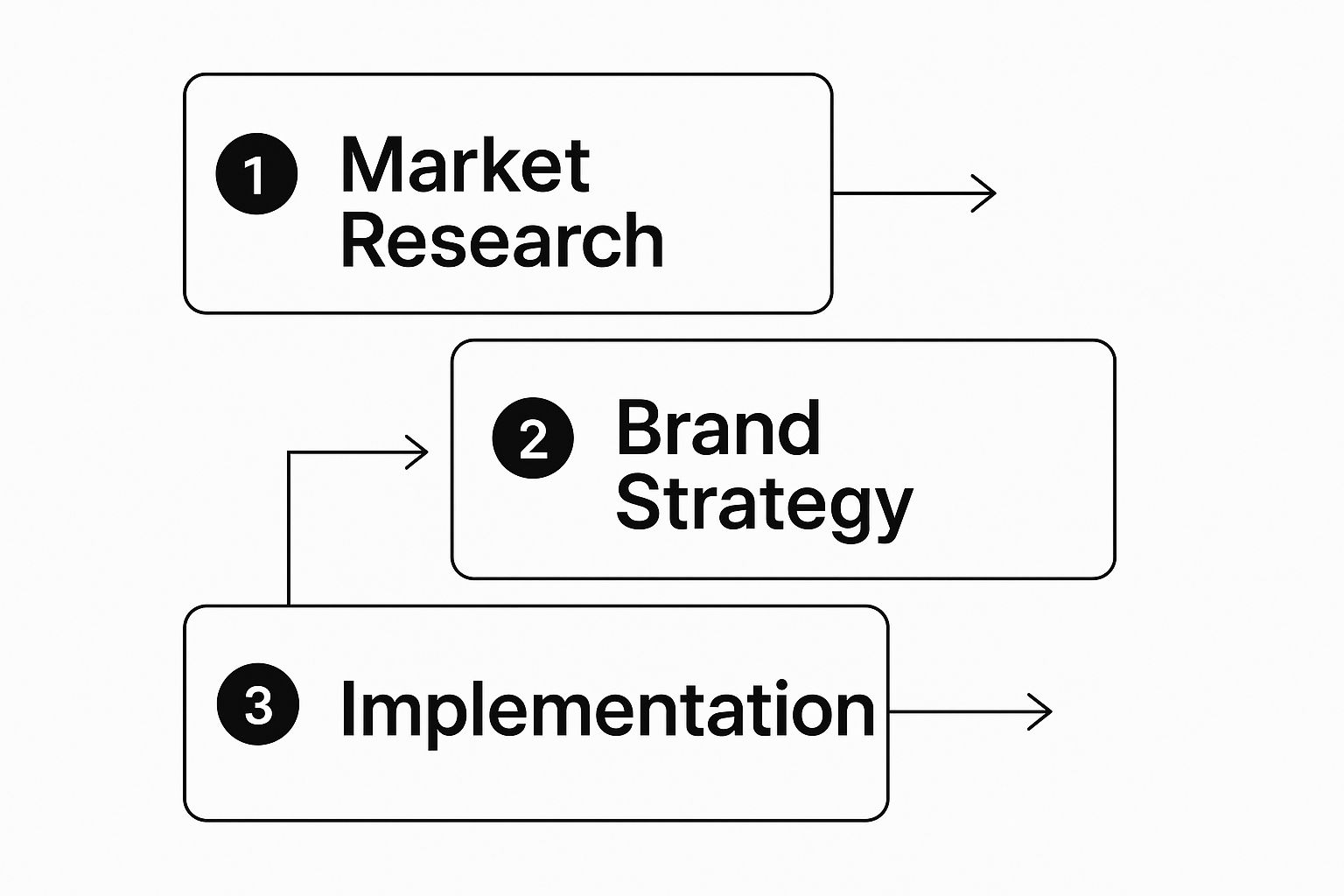Let’s cut through the jargon. Brand development isn't about slapping a logo on something and calling it a day. It’s the long, ongoing journey of shaping how the world sees and feels about your business.
Think of it less like a one-time project and more like building a reputation. It's the continuous process of figuring out your "why," connecting with the right people, and managing every single interaction to build real trust and loyalty.
Understanding the Core of Your Brand

So many people get brand development, branding, and brand identity mixed up. It's easy to see why, but they play very different roles. Branding is the active work of creating your look and your voice, while brand identity is the collection of all those things—your logo, colors, fonts, and so on.
Brand development? That's the master strategy that pulls it all together.
It’s the "why" behind your "what." It’s the long-term vision that makes sure every logo, message, and customer experience works together to build a strong, cohesive reputation that stands the test of time.
This isn't just for massive corporations with huge marketing departments. It's a game-changer for businesses of any size that want to build a lasting connection with their customers. A solid brand development strategy ensures you aren't just selling a product; you’re creating something people genuinely want to be a part of.
Differentiating Key Branding Concepts
To really get what what is brand development, it helps to line it up against the other terms people throw around. The easiest way to think about it is this: Brand development is the master plan, and branding and brand identity are the tools and blueprints you use to bring that plan to life.
Here's a simple breakdown to clear things up:
Brand Development vs Branding vs Brand Identity
| Concept | Focus | Example |
|---|---|---|
| Brand Development | Strategic Process | Deciding to pivot a company from a budget-friendly option to a premium, sustainable brand to attract a new market segment. |
| Branding | Active Implementation | Designing a new, elegant logo, creating eco-friendly packaging, and writing new messaging that reflects the premium shift. |
| Brand Identity | Tangible Assets | The final collection of the new logo, the color palette, the specific fonts, and the tone of voice used across all materials. |
See the difference? This distinction is crucial because it shows that brand development isn't a "one and done" project—it’s a continuous effort.
The impact of getting this right is massive. Just look at how entire countries manage their perception. The United States’ nation brand value recently hit an incredible $37.3 trillion, driven by things like GDP growth and innovation. This shows how strategic development directly builds economic muscle.
Getting a handle on this core concept is the first step. The next is to explore the top brand development strategies you can use to elevate your own business and build something truly meaningful.
The Three Pillars of a Powerful Brand

Every truly great brand, whether it's the corner coffee shop you love or a global tech giant, is built on something much deeper than a cool logo or a snappy name. Those things are just the surface. The real strength—the stuff that makes a brand last—comes from three core pillars that underpin every single decision: Brand Purpose, Brand Positioning, and Brand Personality.
When you get these three right, you stop being just another business and start becoming a memorable, resilient brand. They give you the "why," the "where," and the "who" that steer your entire brand development journey. This ensures everything you create is consistent, authentic, and genuinely compelling.
A brand with a strong foundation knows why it exists, where it fits in the world, and how it should act. This clarity is the difference between being just another option and becoming the only choice for your ideal customer.
Let's break down each of these pillars to see how they work together to build a brand that people actually connect with.
Brand Purpose: The Why
Your Brand Purpose is your reason for being—and no, it’s not just about making money. It's your North Star, the fundamental belief that fuels everything you do. A strong purpose answers the big question: "Why should anyone care?"
Take Patagonia, for example. Their purpose isn't simply to sell outdoor clothing; it's to "save our home planet." This single idea drives everything from their product materials and marketing campaigns to their corporate activism. It gives customers a powerful reason to believe in the brand, not just buy from it.
Brand Positioning: The Where
Brand Positioning is all about carving out a specific, valuable spot for your brand inside your customers' minds. It clearly defines how you're different—and better—than the competition. Let’s be real: you can't be everything to everyone. Positioning is about picking your lane and owning it.
Think about Dollar Shave Club. They certainly didn't invent the razor. What they did was brilliantly position themselves as the smart, affordable, and no-BS alternative to the overpriced "big guys." That crystal-clear positioning in a jam-packed market was the secret sauce to their explosive growth. To start defining your own, check out our complete guide on building a strong brand from the ground up.
Brand Personality: The Who
Finally, we have Brand Personality. This is the set of human traits you give your brand. If your brand walked into a party, who would it be? The wise mentor? The witty friend? The daring innovator? This personality dictates your brand's voice, tone, and style.
It's what makes your emails, ads, and social posts feel authentic and relatable. Just look at Wendy’s famously witty and sarcastic Twitter presence. That’s a perfect example of a brand personality that doesn't just blend in—it stands out and gets people talking on a human level.
A well-defined strategy built on these pillars has a real economic impact. Apple, which recently became the world's first trillion-dollar brand, is a testament to this. It's not just about sleek products; it's the result of decades spent cultivating a purpose-driven, uniquely positioned, and personality-rich brand that commands incredible loyalty. You can see more data on this and find more insights about top global brand valuations on Kantar.com.
A Practical Guide to the Brand Development Process
So you understand what makes a strong brand, but how do you actually build one? It's easy to get lost in theory. The good news is that brand development isn't some mysterious art form. It's a structured journey that turns your big ideas into a living, breathing brand that real people can connect with.
Think of it as a four-part adventure. Breaking it down this way makes the whole thing feel way more manageable. Each stage builds on the one before it, giving you a rock-solid foundation for a brand that doesn't just launch, but lasts.
The goal isn't just to launch a brand, but to build one that can adapt, grow, and stay relevant for years to come. This structured approach makes sure every move you make is deliberate and serves your long-term vision.
Let's walk through these four core stages. We'll look at what happens in each one and what you should be aiming for along the way.
Stage 1: Research and Discovery
This is where you put your ego aside and just listen. Seriously. Before you can decide who you are, you have to understand the world you're stepping into. This means getting your hands dirty with research on your audience, your competitors, and the market itself.

Here's what you'll be doing:
- Audience Deep Dive: Get to know your future customers. Run surveys, conduct interviews, and see what people are saying on social media. What do they need? What are their biggest headaches?
- Competitor Reconnaissance: Scope out the competition. Who are they, what are they great at, and where are they dropping the ball? This is where you'll spot your opening.
- Market Check-Up: Look at the bigger picture. What trends are shaping your industry? What cultural shifts are happening? You want your brand to feel fresh today and tomorrow.
Stage 2: Strategy and Positioning
Okay, research is done. Now it's time to make some decisions. This is where you define your brand's heart and soul. You’re crafting your unique promise and staking your claim in the market. You need a crystal-clear answer to the question, "Why should anyone pick us?"
This is when you solidify those core pillars—your purpose, positioning, and personality. It’s all about creating the foundational documents that will steer every single decision from here on out. Nailing down your brand strategy is a non-negotiable step. For a deeper look, check out our guide on how to build a brand strategy. This is the blueprint for everything that follows.
Stage 3: Identity and Design
Now for the fun part—bringing your strategy to life! This is where you create all the tangible stuff people will see, hear, and interact with. You'll develop your brand's visual and verbal identity, making sure every single element screams you.
Key things you'll create:
- Visual Identity: This includes your logo, your color palette, your fonts, and even guidelines for your photography style.
- Verbal Identity: This is all about your brand voice. How do you sound? What's your tone? What are your key messages?
- Brand Style Guide: The holy grail. You'll put all these visual and verbal rules into one comprehensive document to keep everything consistent, no matter where your brand shows up.
Stage 4: Launch and Management
It's go-time. You're finally ready to introduce your brand to the world. A successful launch is a big, coordinated push, but the work is far from over. Brand management is an ongoing process of monitoring how you're doing, talking with your community, and tweaking your strategy when you need to.
Ultimately, a huge part of this is building recognition. If you want to learn more, there's a fantastic guide on how to build brand awareness that really sticks. This final stage isn't a one-and-done deal; it’s a continuous cycle of doing, measuring, and improving.
Building Unbreakable Brand Trust in the Digital Age
Let's be honest. In a world crammed with ads and a million choices, trust has become a brand's most valuable asset. Seriously. It’s no longer enough to just have a great product. You need to build a real relationship with your audience, one that’s grounded in being reliable and, well, real.
Every single digital interaction—from a quick reply on social media to the tone of your customer support emails—either shores up that bond or starts to chip away at it. This is the new front line of brand development. It’s all about proving your brand is dependable, everywhere, all the time. Consistency isn't just about plastering the same logo everywhere; it's about delivering the same positive, predictable experience, again and again.
Cultivating Authenticity and Transparency
Authenticity just means showing up as you are. Stop selling for a second and start sharing. Share your values, own up to mistakes when they happen (because they will), and have actual conversations with people. Transparency is its partner in crime—it’s about being upfront and honest about everything from your pricing to where you get your materials.
So, how do you actually do this?
- Celebrate User-Generated Content: When a customer tags you in a photo with your product, show it off! It’s a powerful, genuine endorsement that tells your community you see them and you value them.
- Handle Reviews with Grace: Make a point to respond to both glowing and critical reviews. Thanking happy customers shows you’re grateful. Addressing complaints publicly and offering a solution shows you’re accountable. Big difference.
- Create Genuinely Helpful Content: Instead of always pushing for a sale, create blog posts, videos, or guides that actually solve a problem for your audience. This flips the script, positioning you as a trusted expert, not just another seller.
The modern customer is smarter than ever. They don't just buy a product; they buy into a brand's promise and its reputation. Every move you make online adds to the story they tell themselves—and others—about you.
Turning Consistency into Loyalty
And this isn't just fluff; the data backs it up. Recent studies found that a staggering 81% of consumers need to trust a brand before they'll even consider buying from it. And with 77% of consumers saying they prefer to shop from brands they follow on social media, the link between a solid digital presence and real loyalty is crystal clear. If you want to dive deeper into the numbers, ExplodingTopics.com has a great breakdown of current consumer trends.
Making sure your message, values, and vibe are consistent across every platform is non-negotiable. To keep everything aligned, it’s a good habit to step back and check how your brand is actually perceived out in the wild. We've put together a guide that walks you through this exact process: how to do a brand audit. Think of it as a tune-up, ensuring every touchpoint reinforces the unbreakable trust you’re working so hard to build.
How to Measure Your Brand's Growth and Success
A great brand development strategy doesn't just feel right—it delivers real, tangible results. But how do you actually prove its value beyond a hunch? To know if your hard work is paying off, you have to track the right numbers. I'm not talking about vanity metrics like social media likes; I mean the signals that show true brand health and directly connect your reputation to your bottom line.

When you measure effectively, you can see what's working, what's falling flat, and where to put your energy and resources for the biggest impact. It’s about confidently steering your brand’s future and showing a clear return on all that effort.
Tracking Brand Awareness
First things first: do people even know you exist? Brand awareness is all about how familiar your target audience is with who you are. Are you the first name they think of, or just another face in a very crowded room? Building awareness is the bedrock for everything else.
Here’s how you can keep a pulse on it:
- Social Media Mentions: Use a listening tool to catch every time your brand's name is dropped on social media. A jump in untagged mentions is a fantastic sign that people are talking about you organically.
- Direct Website Traffic: This one’s a big deal. When someone types your website URL straight into their browser, it means they know you by name. It’s a powerful sign of strong brand recall.
- Search Volume Data: Watch for an increase in people searching for your brand name on Google. This is a direct measure of growing curiosity and recognition.
Gauging Brand Equity and Loyalty
Okay, so people know who you are. The next question is, what do they think of you? Brand equity is the value your brand holds in a customer's mind. When it's positive, people will choose you over a competitor, even if you cost a little more.
A strong brand makes the choice easy. It’s the sum of every experience a customer has with you, creating a level of trust that makes them less sensitive to price and more resistant to competitors.
To get a read on this, look at:
- Customer Lifetime Value (CLV): This number represents the total revenue you can expect from a single customer over their entire relationship with you. A rising CLV is a great indicator that your brand is fostering loyalty and encouraging repeat business.
- Net Promoter Score (NPS): A simple but powerful survey that asks customers how likely they are to recommend you. It's a direct gauge of their satisfaction and loyalty.
- Customer Retention Rate: How many of your customers are sticking around? A high retention rate is a clear signal of a healthy, trusted brand that people want to come back to.
Connecting these data points to a bigger picture is where the magic happens. By truly understanding your numbers, you can fine-tune your approach and build a more powerful growth marketing strategy.
Let's break down some of the most important metrics you should be tracking.
Key Metrics for Tracking Brand Development ROI
This table is a practical guide to the metrics that really matter. It shows you not just what to track, but how to track it and what it reveals about your brand's overall health and success.
| Metric Category | Specific Metric | What It Measures |
|---|---|---|
| Awareness | Share of Voice | Your brand's visibility in the market compared to competitors. |
| Website Traffic Sources | How people are finding you (e.g., direct, organic search, social media). | |
| Social Media Reach | The total number of unique people who see your content. | |
| Engagement | Social Media Engagement | Likes, comments, shares, and saves, indicating audience interaction. |
| Bounce Rate | The percentage of visitors who leave your site after viewing only one page. | |
| Average Session Duration | How long visitors are spending on your site, signaling interest in your content. | |
| Loyalty & Equity | Customer Lifetime Value | The total revenue a customer generates for your business over their entire relationship. |
| Net Promoter Score (NPS) | Customer willingness to recommend your brand to others, a key indicator of loyalty. | |
| Customer Retention Rate | The percentage of customers you keep over a specific period. | |
| Revenue Impact | Customer Acquisition Cost | The cost associated with convincing a customer to buy a product or service. |
| Conversion Rate | The percentage of users who take a desired action (e.g., make a purchase, sign up). | |
| Revenue from Branded Search | The income generated from customers who found you by searching specifically for your brand. |
By keeping a close eye on these metrics, you move beyond guesswork. You get a clear, data-backed picture of how your brand is performing, allowing you to make smarter decisions that drive real growth.
Frequently Asked Questions About Brand Development
Alright, we've just gone through the whole brand development playbook, from start to finish. I know it's a lot to take in, and you probably have some practical questions buzzing around your head right now. It’s a big deal, so it's totally normal to be wondering about the "when," the "how much," and the "what not to do."
Let's tackle some of the most common questions I hear. My goal is to clear things up so you can move forward with confidence.
How Often Should a Company Revisit Its Brand Strategy?
Think of your brand strategy as the course you've plotted for your ship. You don't need to reinvent the whole map every week, but you can't just set it and forget it, either. A major review every 3-5 years is a good rule of thumb. You'll also want to do a deep dive anytime there's a huge shift in the market—think a disruptive new technology or a major competitor crashing the party.
But you should be checking your instruments way more often than that. I recommend quarterly check-ins on your key brand metrics. This lets you make small, smart adjustments to stay on course, preventing the need for a massive, painful overhaul down the line. Tracking things like an increase in brand awareness is absolutely critical for knowing if you're succeeding.
Can a Small Business With a Tiny Budget Actually Do This?
Yes. 100% yes. So many people think effective brand development is about having a massive war chest, but it’s not. It’s about being incredibly clear and relentlessly consistent.
The most powerful first step you can take costs absolutely nothing: get crystal clear on why you exist and who you're here to serve.
Once you have that, just focus on delivering a consistent experience everywhere. I mean everywhere—from the tone of your emails to how you handle a customer complaint. Building a rock-solid reputation through genuine, authentic interactions costs you more time than money, and for a small business, it’s one of the most powerful moves you can make.
The most damaging mistake is inconsistency. It’s when your marketing promises one thing, your product delivers another, and your customer service feels completely different. This erodes trust, which is the bedrock of any strong brand.
A winning brand makes sure its promise is kept at every single touchpoint, no exceptions. People often mix this up with just having a cool logo, but they're worlds apart. It's worth taking a minute to understand the difference between branding vs. logo design to make sure you're putting your energy where it'll make the biggest impact.
Ready to bring your brand vision to life? At Creativize, we connect you with talented local professionals who specialize in turning great strategies into unforgettable brand identities. Find the perfect creative partner to help you build a brand that stands out. Explore creative talent on Creativize today.

